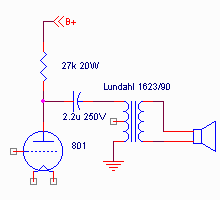
Input and Driver Stage
There are a number of possible configurations for the input section to this amplifier. Lets review the requirements. Since the "output" stage is a group of paralleled inverted triodes, a relatively high voltage level at moderate impedance is needed. More specifically, at least 100VRMS (280 volts p-p) is needed. The total input capacitance for the output stage is approximately 300 pf, including wiring, Miller effects, and Cpk (acting as the control grid). Since a very good HF response is desired, I considered making the desired 3 dB point about 100kHz. This means the driver must have an output impedance less than R=1/(2*PI*100kHz*300pf) = about 5k ohms. This can be achieved with several devices. Since I also wanted to use a DHT device, the choices for driver settled in between the 801 (10, 10Y etc), 6B4, 50 and similar types. (The 71A was considered, but rejected due to the required voltage swing).
The overall gain of the amplifier needs to be about 40 dB (x100), since a 100VRMS signal to drive the output stage divided by the gain gives the input sensitivity; a 1 volt sensitivity seems appropriate.
After several considerations, 3 finalists remained: 6SL7 driving a 6B4, 6SN7 driving an 801, and an 841 driving an 801. The third choice was really interesting, allowing a test of an all DHT "front end". I actually built up all 3 types. I discarded the 6SL7/6B4 choice, as not sounding quite as nice as the 6SN7/801. After further investigation, this was found to be the result of merely frequency response limitations in the topology. I may re-investigate that topology at some point. The 841/801 likewise was response limited (to only about 30kHz) due to the capacitance associated with the 841. At some point, I'll re-investigate that topology. For now, I chose the 6SN7/801 as it sounded quite nice, and provided the gain and response characteristics I was looking for.
The first step in optimizing the amp was to eliminate the hum associated with the DHT. This was an investigation in its own. This report can be viewed by clicking here.
Since I wanted VERY wide range response, the coupling capacitor to the output stage would need to be very large. In order to avoid the non-linear characteristics associated with capacitors (see report), I chose to split the supply into + and - 300 volts for the driver stage. This also avoids *very* large voltages with respect to ground. The driver stage then idles at about 25 volts with respect to ground, so for a negative bias on the output stage of -150 volts, only a 200 volt capacitor is needed. I had some nice 2.2uF 250 volt parts I ended up using.
The gain distribution in this pair also allows a very low distortion input driver configuration: the 801 provides a stage gain of about 6, so that the required drive level for 100VRMS is only about 16VRMS, which a 6SN7 can do with low distortion. For the input + driver:, the following distortion characteristics were obtained:
| Output Level VRMS | % 2nd | % 3rd | %4th | %5th |
| 50 | 0.2 | 0.05 | 0.006 | - |
| 70 | 0.24 | 0.08 | 0.018 | 0.004 |
| 100 | 0.33 | 0.24 | 0.08 | 0.02 |
| 130 | 0.4 | 0.4 | 0.1 | 0.09 |
This performance was acceptably good. Note that the 801 is run with 6.3V (actually measured 6.6V) on its filament, in a slightly starved condition, which actually improves the distortion characteristics (see report).
The measured gain was almost exactly 100 (40 dB) with the amplifier, and the measured frequency response was about 4Hz to about 100kHz with 300pF loading inserted on the output to simulate the 6080 stage. S/N measured about 82 dB.
To get a schematic of the entire stereo input + driver amplifier, please EMail me (sbench@aol.com).
Listening Tests
To verify that the driver stage was going to be acceptable, I turned it into a full SE amplifier simply by adding a transformer to the output of the 801 AFTER the output coupling capacitor, so as to preserve the stage operating points as much as possible. The "snippet" of schematic to do this is:

This is *not* a very efficient way of running the amplifier, but is "similar" to parafeed operation with a *very* lossy choke. It created a "mighty" 0.5 watts of audio before clipping!
I auditioned this circuit to an audience of about 10 people. (the stereo amp + a CD player + a set of homemade "transmission line" speakers). The speakers had a sensitivity of about 89 dB and about 40-18kHz response.
Since the 801s are DHT devices, they "come up" within a second or two. It's very wierd to hear a little residual hum from the system and have it absolutely disappear as the 6SN7 comes up to operating conditions. (If you stick your ear exactly against the speaker, you can hear just a slight amount of residual hum and noise. 1" away, and it's gone).
The sound is extremely detailed. The imaging is absolutely wonderful. The group unanimously agreed. Very smooth. The input and driver stage alone makes a very nice amp.
The very soft clipping characteristic of the DHT with AC filaments was also in evidence. Until you got FAR into clip, it was almost impossible to hear the clipping. The focusing was not lost during clip either, which somewhat surprised me. Sound stage stayed exactly as it was.
If you listened carefully during clip conditions, you could hear the hum modulation (not hum, but the 120Hz modulation). Only two people in the group were able to hear that effect.
The audition lasted for about an hour.
-Steve